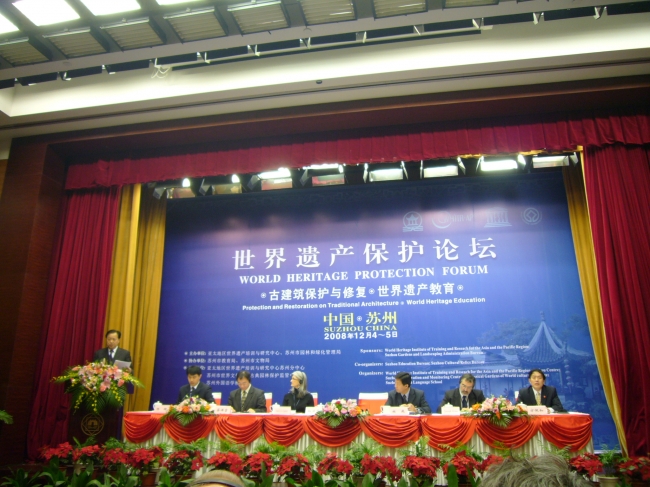| Suzhou World Heritage Protection Forum —— Traditional Architecture Protection and Restoration • World Heritage Education |
| PublishDate:2008-12-10 Hits:3400 |
 From November 4th to 5th, 2008, the World Heritage Protection Forum was held in Suzhou. This Forum was co-hosted by the UNESCO WHITR-AP (World Heritage Institute of Training and Research for the Asia and the Pacific Region under the auspices of UNESCO) and the SuzhouGardens and Landscaping Administration Bureau. More than one hundred experts, scholars and technicians coming from UNESCOWorldHeritageCenter, ICCROM (InternationalCenter for the study of Preservation and Restoration of Cultural Property) and some other organizations at home and abroad attended the forum. Their discussion mainly focused on two topics: one is the skill to protect and restore the traditional architecture; the other is how to better carry out the world heritage education. From November 4th to 5th, 2008, the World Heritage Protection Forum was held in Suzhou. This Forum was co-hosted by the UNESCO WHITR-AP (World Heritage Institute of Training and Research for the Asia and the Pacific Region under the auspices of UNESCO) and the SuzhouGardens and Landscaping Administration Bureau. More than one hundred experts, scholars and technicians coming from UNESCOWorldHeritageCenter, ICCROM (InternationalCenter for the study of Preservation and Restoration of Cultural Property) and some other organizations at home and abroad attended the forum. Their discussion mainly focused on two topics: one is the skill to protect and restore the traditional architecture; the other is how to better carry out the world heritage education.This meeting aims at establishing a communication platform for the research on protecting and restoration skills, showing the fruits of world cultural heritage protection and restoration in different regions of China, and discussing the development of this cause together. It also aims at further improving the exchange and communication in traditional architecture protection among scientific research institutions, colleges and universities, architectural restoration enterprises and world heritage administration institutions. New contributions will be made to promote the overall technical level of Asia-Pacific Region in world heritage protection and restoration. In the parallel session of “Traditional Architecture Protection and Restoration”, the participants mainly focused on introducing the heritage protection experience of different nations, such as the ICCROM’s protection of the Roman Central Traditional Architecture, protection and restoration of Mont-Saint-Michel, Seoul’s protection of its city wall and historical landscape, and Bhutan’s protection of its architectural heritage. At the same time, this session also thoroughly discussed about the protection and restoration of several Chinese heritage sites, such as the seismic restoration of Pengzhou Annunciation Cathedral, the latest technologies on restoring and protecting the modern historical architecture facade, and the protection and restoration of Tang Dynasty’s Daming Palace Relics. In the parallel session of “World Heritage Education”, the participants introduced such issues as the current situation of world heritage education in China, U.N.’s formal and informal plans on heritage education, U.N.’s new agreement about this education in East Asia (the new Silk Road), and the relationship between cultural heritage and quality education for teenagers. |
- News | WHITRAP Shanghai and CNR-ISPC bilateral meeting
- News | WHITRAP meets Cité de l’Architecture et du Patrimoine
- WHITRAP Hosting "Workshop on Preliminary Assessment for National Focal Points of the Asia Region" in Chengdu
- WHITRAP Shanghai meets UNESCO
- INTERNATIONAL CONFERENCE PRELIMINARY ANNOUNCEMENT & CALL FOR PAPERS
- Observation of the 46th Session of the World Heritage Committee
Copyright © 2009-2012 World Heritage Institute of Training and Research-Asia and Pacific (shanghai)


